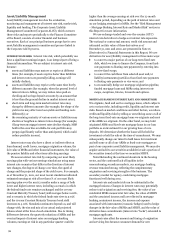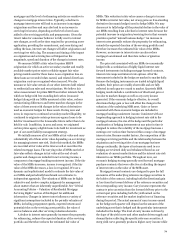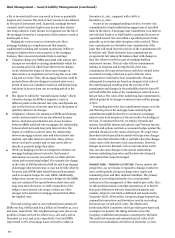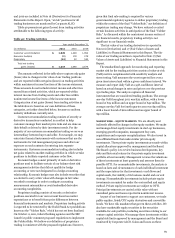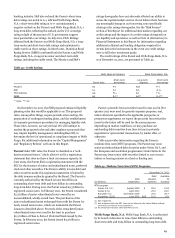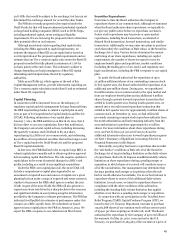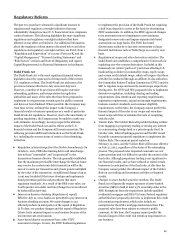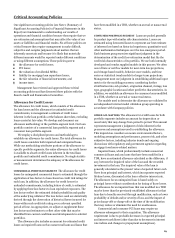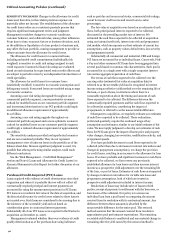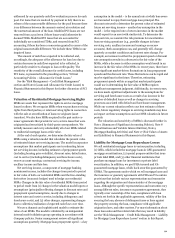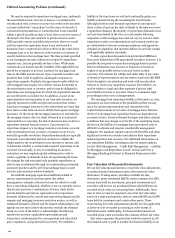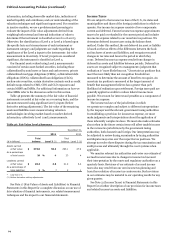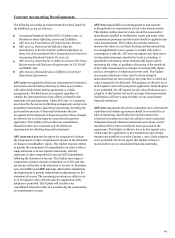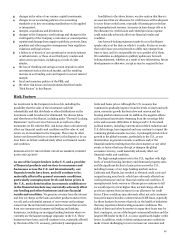Wells Fargo 2011 Annual Report Download - page 89
Download and view the complete annual report
Please find page 89 of the 2011 Wells Fargo annual report below. You can navigate through the pages in the report by either clicking on the pages listed below, or by using the keyword search tool below to find specific information within the annual report.
Regulatory Reform
The past two years have witnessed a significant increase in
regulation and regulatory oversight initiatives that may
substantially change how most U.S. financial services companies
conduct business. The following highlights the more significant
regulations and regulatory oversight initiatives that have
affected or may affect our business. For additional information
about the regulatory reform matters discussed below and other
regulations and regulatory oversight matters, see Part I, Item 1
“Regulation and Supervision” of our 2011 Form 10-K, and the
“Capital Management,” “Forward-Looking Statements” and
“Risk Factors” sections and Note 26 (Regulatory and Agency
Capital Requirements) to Financial Statements in this Report.
Dodd-Frank Act
The Dodd-Frank Act is the most significant financial reform
legislation since the 1930s and is driving much of the current
U.S. regulatory reform. The Dodd-Frank Act and many of its
provisions became effective in July 2010 and July 2011.
However, a number of its provisions still require extensive
rulemaking, guidance, and interpretation by regulatory
authorities and many of the rules that have been proposed to
implement its requirements remain open for public comment
and have not been finalized. Where possible, the Company may,
from time to time, estimate the impact to the Company’s
financial results or business operations as a result of particular
Dodd-Frank Act regulations. However, due to the uncertainty of
pending regulations, the Company may be unable to make any
such estimates. Accordingly, in many respects the ultimate
impact of the Dodd-Frank Act and its effects on the U.S.
financial system and the Company still remain uncertain. The
following provides additional information on the Dodd-Frank
Act, including the current status of certain of its rulemaking
initiatives.
Regulation of interchange fees (the Durbin Amendment). On
October 1, 2011, FRB rules limiting debit card interchange
fees to those "reasonable" and "proportional" to the
transactions became effective. The rule generally established
that the maximum permissible interchange fee that an issuer
may receive for an electronic debit transaction will be the
sum of 21 cents per transaction and 5 basis points multiplied
by the value of the transaction. An additional charge of up to
1 cent may be added if the issuer develops and implements
fraud prevention policies and procedures that meet
regulation standards. As a result of the FRB’s new rules, our
fourth quarter 2011 debit card interchange fees were reduced
by $365 million (pre-tax).
Interest on business checking (Regulation Q repeal).
Effective July 21, 2011, banks are permitted to pay interest on
business checking accounts. We made changes to our
affected products in anticipation of the repeal of Regulation
Q. To date, our product changes and the repeal of Regulation
Q have had a minimal impact on our business because of the
low interest rate environment.
Asset-based deposit assessment base; other FDIC
assessment changes. In 2011, the FDIC finalized regulations
to implement the provision of the Dodd-Frank Act requiring
a shift from deposits to assets as the basis for determining
FDIC assessments. In addition, the FDIC approved changes
to its assessment rates to implement a new minimum
designated reserve ratio and impose separate risk-based
assessments on large banks. The FDIC has broad
discretionary authority to increase assessments on large
financial institutions such as Wells Fargo on a case by case
basis.
Regulation of swaps and other derivatives activities. The
Dodd-Frank Act establishes a comprehensive framework for
regulating over-the-counter derivatives. Included in this
framework are certain “push-out” provisions affecting U.S.
banks acting as dealers in commodity swaps, equity swaps
and certain credit default swaps, which will require that these
activities be conducted through an affiliate. It also authorizes
the Commodity Futures Trading Commission (CFTC) and the
SEC to regulate swaps and security-based swaps respectively.
During 2011, the CFTC and SEC proposed rules to implement
derivatives regulation, including clearing and trading
requirements, data retention and reporting requirements,
registration requirements, capital and margin requirements,
business conduct standards, and customer eligibility
requirements. At this time, the Company cannot predict the
financial impact of the rules to our swaps and securities-
based swaps activities or estimate the costs of complying
with the rules.
Volcker Rule. The Volcker Rule will prohibit banking entities
from engaging in proprietary trading or owning any interest
in or sponsoring a hedge fund or a private equity fund. In
October 2011, federal banking agencies and the SEC issued
for public comment proposed regulations to implement the
Volcker Rule. The comment period ended on
February 13, 2012, and the Volcker Rule will become effective
on July 21, 2012, regardless of the status of the rulemaking
process. The proposed rules requested comments on over
1,300 questions and it is difficult to predict the content of the
final rules. Although proprietary trading is not significant to
our financial results, and we have reduced or exited certain
businesses in anticipation of the final rules, at this time the
Company cannot predict the ultimate impact of the Volcker
Rule on our trading and investment activities or financial
results.
Changes to asset-backed securities markets. The Dodd-
Frank Act will generally require sponsors of asset-backed
securities (ABS) to hold at least a 5% ownership stake in the
ABS. Exemptions from the requirement include qualified
residential mortgages and FHA/VA loans. Federal regulatory
authorities have proposed joint rules to implement this credit
risk retention requirement, which rules include an
exemption for the GSE’s mortgage-backed securities. The
proposed rules have been subject to extensive public
comment. At this time, the Company cannot predict the
financial impact of the credit risk retention requirement on
our business.
87



